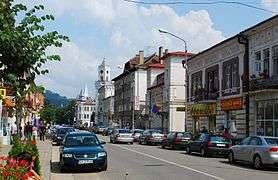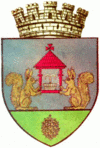Vatra Dornei
| Vatra Dornei | ||
|---|---|---|
| Municipality | ||
|
Mihai Eminescu Street, downtown Vatra Dornei | ||
| ||
 Vatra Dornei Location of Vatra Dornei | ||
| Coordinates: 47°20′46″N 25°21′34″E / 47.34611°N 25.35944°ECoordinates: 47°20′46″N 25°21′34″E / 47.34611°N 25.35944°E | ||
| Country |
| |
| County | Suceava County | |
| Status | Municipality | |
| Government | ||
| • Mayor | Ilie Boncheș (Democratic Liberal Party) | |
| Area | ||
| • Total | 144.34 km2 (55.73 sq mi) | |
| Population (2011 census)[1] | ||
| • Total |
| |
| • Density | 95/km2 (250/sq mi) | |
| Time zone | EET (UTC+2) | |
| • Summer (DST) | EEST (UTC+3) | |
| Climate | Dfb | |
| Website | Official site | |
Vatra Dornei (Romanian pronunciation: [ˌvatra ˈdornej]; German: Dorna-Watra; Hungarian: Dornavátra) is a city in Suceava County, north-eastern Romania. It is situated in the historical region of Bukovina. Vatra Dornei is the fifth largest urban settlement in the county, with a population of 13,659 inhabitants, according to the 2011 census. It was declared a municipality in 2000, being the newest and smallest municipality in the county. The city administers three villages: Argestru, Roșu and Todireni. Vatra Dornei is a well known spa and ski resort in the Carpathian Mountains.
Geography
Vatra Dornei is located in north-east Romania, in the south-western part of Suceava County, 110 km away from Suceava, the capital of the county. The city of Câmpulung Moldovenesc is 40 km away, the city of Bistrița 85 km away, the town of Gura Humorului 74 km away and the town of Broșteni 52 km away.
Vatra Dornei is at the confluence of Bistrița River and Dorna River, in Dorna Depression. Because of its mountain surroundings, the city is a spa and ski resort, one of the oldest resorts in Romania. Vatra Dornei is connected to the Romanian national railway system and has two railway stations, Vatra Dornei and Vatra Dornei Băi, both historical monuments. The European route E58, that links the region of Moldavia with Transylvania, crosses the city.
History
The earliest written mention of the settlement is from 1592. Together with the rest of Bukovina, Vatra Dornei was under the rule of the Habsburg Monarchy (later Austria-Hungary) from 1775 to 1918. This was a period of development for the town, which became a well known resort in the early 19th century. Between 1925-1950, Vatra Dornei was part of the former Câmpulung County. From 1950 to present it's part of Suceava County.
Demographics
| Historical population | ||
|---|---|---|
| Year | Pop. | ±% |
| 1930 | 9,826 | — |
| 1948 | 7,078 | −28.0% |
| 1956 | 10,822 | +52.9% |
| 1966 | 13,815 | +27.7% |
| 1977 | 15,873 | +14.9% |
| 1992 | 18,488 | +16.5% |
| 2002 | 16,321 | −11.7% |
| 2011 | 13,659 | −16.3% |
| Source: Census data | ||
Until the 1950s Vatra Dornei had a mixed population of Romanians, Ukrainians, Jews and Germans. The large synagogue and a picturesque Jewish cemetery bear witness to the Jewish presence in the area.
Vatra Dornei reached its peak population in 1992, when about 18,500 people were living within the town limits. Then the city population declined gradually. According to the 2011 census, Vatra Dornei had a total population of 13,659 inhabitants. Of this population, 98.65% are ethnic Romanians, 0.64% Roma, 0.23% Germans, 0.22% Hungarians and 0.10% Ukrainians.
Vatra Dornei is the fifth most populated urban settlement in Suceava County, after the county capital, Suceava, and the cities of Fălticeni, Rădăuţi and Câmpulung Moldovenesc. Vatra Dornei is also the smallest and newest municipality in Suceava County.
Tourism
Vatra Dornei is a well known ski resort in the Carpathian Mountains. There are ski slopes nearby the city, attracting tourists in winter season. Vatra Dornei is surrounded by large forest areas, proper places for practicing alpine tourism. There are mineral water springs in the city limits and its surroundings, that helped the settlement to develop as a spa. In the late 19th century and early 20th century Bukovina had only two spa towns: Vatra Dornei and Solca.
Vatra Dornei has several hotels, two museums (The Ethnographic Museum and The Museum of Natural Sciences) and a few old buildings that are considered historical and architectural monuments: the casino, the main spa building, the two railway stations, the town hall, Sentinela Spring, the post office building, and a few old churches.
Natives
- Vasile Deac (1824-1909) - Mayor of Vatra Dornei
- Platon Pardău (1934-2002) - poet and writer
Gallery
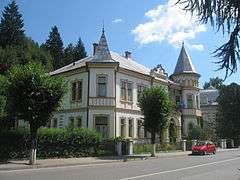 City Library
City Library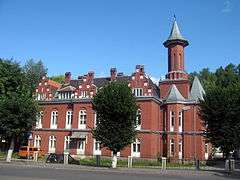 Vladimir House
Vladimir House- Holy Trinity Cathedral
 Carol Hotel
Carol Hotel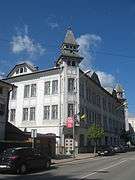 Court
Court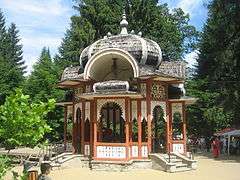 Japanese Pavilion
Japanese Pavilion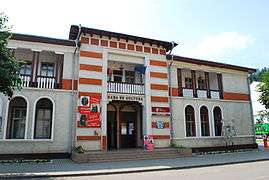 House of Culture
House of Culture Dealul Negru slope
Dealul Negru slope Unirea Spring
Unirea Spring Sentinela Spring
Sentinela Spring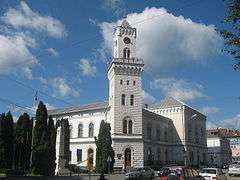 City Hall
City Hall Great Jewish Temple
Great Jewish Temple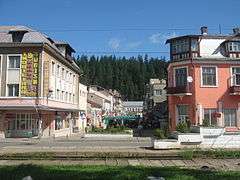 Luceafărul Street
Luceafărul Street Vatra Dornei Băi railway station
Vatra Dornei Băi railway station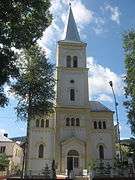 Roman Catholic Church
Roman Catholic Church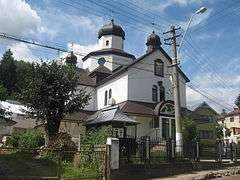 St. Elijah Church
St. Elijah Church
References
- ↑ "Suceava County at the 2011 census" (PDF) (in Romanian). INSSE. February 2, 2012. Retrieved March 12, 2012.
External links
| Wikimedia Commons has media related to Vatra Dornei. |
- (Romanian) Vatra Dornei Town Hall official site
- (Romanian) Vatra Dornei unofficial site
- (Romanian) Vatra Dornei touristic site
- (Romanian) The City Hospital of Vatra Dornei
- (Romanian) Vatra Dornei Live - Local news site
- (Romanian) Suceava County site - Vatra Dornei web page
- (Romanian) Photo Gallery - Old photos of Vatra Dornei
